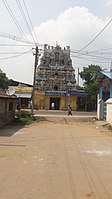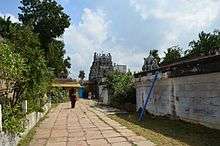Hara Saabha Vimocchana Perumal Temple
| Hara Saabha Vimocchana Perumal Temple | |
|---|---|
 | |
 Location in Tamil Nadu | |
| Geography | |
| Coordinates | 10°51′36″N 79°6′30″E / 10.86000°N 79.10833°ECoordinates: 10°51′36″N 79°6′30″E / 10.86000°N 79.10833°E |
| Country | India |
| State | Tamil Nadu |
| District | Thanjavur |
| Location | Tamilnadu, India |
| Culture | |
| Sanctum | Hara Saabha Vimocchana Perumal (Vishnu) |
| Architecture | |
| Architecture | Dravidian architecture |
Hara Saabha Vimochana Perumal Temple in Thirukandiyur, a village in the outskirts of Thiruvayaru in the South Indian state of Tamil Nadu, is dedicated to the Hindu god Vishnu. Constructed in the Dravidian style of architecture, the temple is glorified in the Divya Prabandha, the early medieval Tamil canon of the Azhwar saints from the 6th–9th centuries AD. It is one of the 108 Divyadesam dedicated to Vishnu, who is worshipped as Hara Saabha Vimochana and his consort Lakshmi as Kamalavalli.
The temple is believed to have been built by the Medieval Cholas of the late 8th century AD, with later contributions from Vijayanagar kings and Madurai Nayaks. A granite wall surrounds the temple, enclosing all its shrines and its bodies of water. The temple has a 5-tiered rajagopuram, the temple's gateway tower.
Hara Saabha Vimochana is believed to have appeared to Hindu gods Brahma and Shiva, and King Mahabali. Six daily rituals and four yearly festivals are held at the temple, of which the Panguni Brahmostavam, celebrated during the Tamil month of Panguni (April–May), is the most prominent. The temple is maintained and administered by the Hindu Religious and Endowment Board of the Government of Tamil Nadu.
Legend

As per the account in Brahmanda Purana, Brahma, the Hindu god of creation and Shiva, the Hindu god of destruction, had originally five heads. Parvati, the wife of Shiva, once got confused and worshipped Brahma, instead of her husband. Shiva got enraged and cut off one of Brahma's heads; the head stuck to Shiva's hand due to Brahma's curse. To get rid off the sin, Shiva worshipped the god Vishnu at Thirukarambanur as Bhikshatana, where a part of his sin was relieved. Shiva freed himself from the sin after visiting Vishnu at Thirukandiyur and taking a holy dip in the temple tank, Kamala Pushkarani. Since Vishnu relieved (vimochana) the sin (saabha) of Shiva (also called Hara), the temple is called Hara Saabha Vimochana Temple. After the incident, the tank came to be known as Kapala Theertham (kapala indicates skull). Shiva was pleased and he built the Hara Sabha Vimochana temple and also built a temple for himself near it.[1][2]
As per another legend, Lakshmi, the consort of Vishnu requested Shiva to cut off one of Brahma's heads as she felt that Vishnu would ignore her and show all his affection towards Brahma. Sage Bhrigu, King Mahabali and the moon-god Chandra expiated their sins, worshipping Vishnu here. Sage Bhrigu, once wanted to test the superior of the Trinity of Brahma, Vishnu and Shiva. He kicked Vishnu in his chest in anger; the sage atoned here. Chandra sinned by seducing his guru's wife; he partially expiated by worshipping here.[1]
History
The temple is believed to have been built by the Medieval Cholas of the late 8th century AD, with later contributions from Vijayanagar kings and Madurai Nayaks. In modern times, the recorded temple renovation was carried out in 1984 under the aegis of seer Sri Thirukudanthai Vedanta Ramanuja Mahadesikan. The renovation is 2003 was carried out by his successor Sri Rangaramanuja Mahadesikan. The works involved renovation of the gateway tower and the shrines of Hara Saabha Vimocahana and Kamalavalli.[1] The oldest deities of the temple are found to be that of Santana Gopala and Navneetha Krishna. It is believed that Tipu Sultan, the king of Mysore fought and won a war at this place and later became a devotee of the temple.[3]
Architecture

Hara Saabha Vimocchana Perumal Temple is located in Thirukandiyur, a village located between Thiruvayyaru and Thanjavur, in between the rivers Cauvery and Kudamaurutti.[4] The temple has a three-tiered rajagopuram (gateway tower) and an adjoining granite wall that surrounds the temple. The temple occupies an area of 1 acre (0.0040 km2) and is located in the between the rivers Kudamurutti and Vennar. The temple is located 2 km (1.2 mi) away from Thiruvayaru in Thanjavur district. The temple has two precincts and the main gateway faces the east. The central shrine houses the image of Hara Saabha Vimochana Perumal in standing posture. The sanctum is approached through two halls, namely, the Garuda Mandapam and the Maha Mandapam. Kapala Moksha Pushkarani, located on the west side of the temple is the major water body associated with the temple, while the Mahabali Theertham is located opposite to it. The shrine of the consort of Hara Saabha Vimochana, Kamalavalli or Kamala Nachiyar, is located in the first precinct. The second precinct houses the shrines for Narasimha, Sudarsana, Andal, Azhwars and Desika.[1]
Religious significance
The temple is revered in Nalayira Divya Prabandham, the 7th–9th century Vaishnava canon, by Thirumangai Azhwar in ten hymns. The temple is classified as a Divyadesam,[5] one of the 108 Vishnu temples that are mentioned in the book.[6] The temple is one of the few historical temples in India where the images of Hindu trimurti, Vishnu, Shiva and Brahma are housed in the same premises. It is one of the two temples in Chola Nadu where the trimurti can be seen in the same premises, the other being Uttamar Kovil near Tiruchirapalli. The shrines of Brahma and his consort Saraswati were dilapidated during the course of time. The place is called by different names like Kandiyur, Kandana Kshetram and Pancha Kamala Kshetram, and is believed that devotees get relieved off their Brahmahatti Dosha after visiting the temple. The temple is considered older than Srirangam Ranganathaswamy temple and believed to be in existence from the Treta Yuga.[1]
Festivals and religious practices
The temple priests perform the pooja (rituals) during festivals and on a daily basis. As at other Vishnu temples of Tamil Nadu, the priests belong to the Vaishnavaite community, a Brahmin sub-caste. The temple rituals are performed six times a day: Ushathkalam at 7 a.m., Kalasanthi at 8:00 a.m., Uchikalam at 12:00 p.m., Sayarakshai at 6:00 p.m., Irandamkalam at 7:00 p.m. and Ardha Jamam at 10:00 p.m. Each ritual has three steps: alangaram (decoration), neivethanam (food offering) and deepa aradanai (waving of lamps) for both Hara Saabha Vimochana and Kamalavalli. During the last step of worship, nagaswaram (pipe instrument) and tavil (percussion instrument) are played, religious instructions in the Vedas (sacred text) are recited by priests, and worshippers prostrate themselves in front of the temple mast. There are weekly, monthly and fortnightly rituals performed in the temple. Four major festivals are celebrated in the temple, namely, the Panguni Brahmmotsavam celebrated during the Tamil month in Panguni (March–April), Aipasi Pavithra Utsavam in Aipasi (October–November), Vaikunta Ekadashi in Margazhi (December–January) and Karthikai Deepam in Karthikai (November–December).[6]
References
- 1 2 3 4 5 T.A., Srinivasan (21 March 2003). "Temple for the Great Trinity". The Hindu. Retrieved 21 February 2016.
- ↑ Ayyar, P. V. Jagadisa (1982). South Indian Shrines: Illustrated. New Delhi: Asian Educational Services. p. 534. ISBN 9788120601512.
- ↑ R., Dr. Vijayalakshmy (2001). An introduction to religion and Philosophy - Tévarám and Tivviyappirapantam (1st ed.). Chennai: International Institute of Tamil Studies. pp. 458–9.
- ↑ "Temple for the Great Trinity". The Hindu. 11 June 2005. Retrieved 21 February 2016.
- ↑ "An NGO does its bit for god - and humanity". New Delhi, India: Hindustan Times. 29 April 2007. Retrieved 13 April 2018 – via High Beam. (Subscription required (help)).
- 1 2 "Sri Hara Shaba Vimochana Perumal temple". Dinamalar. Retrieved 21 February 2016.